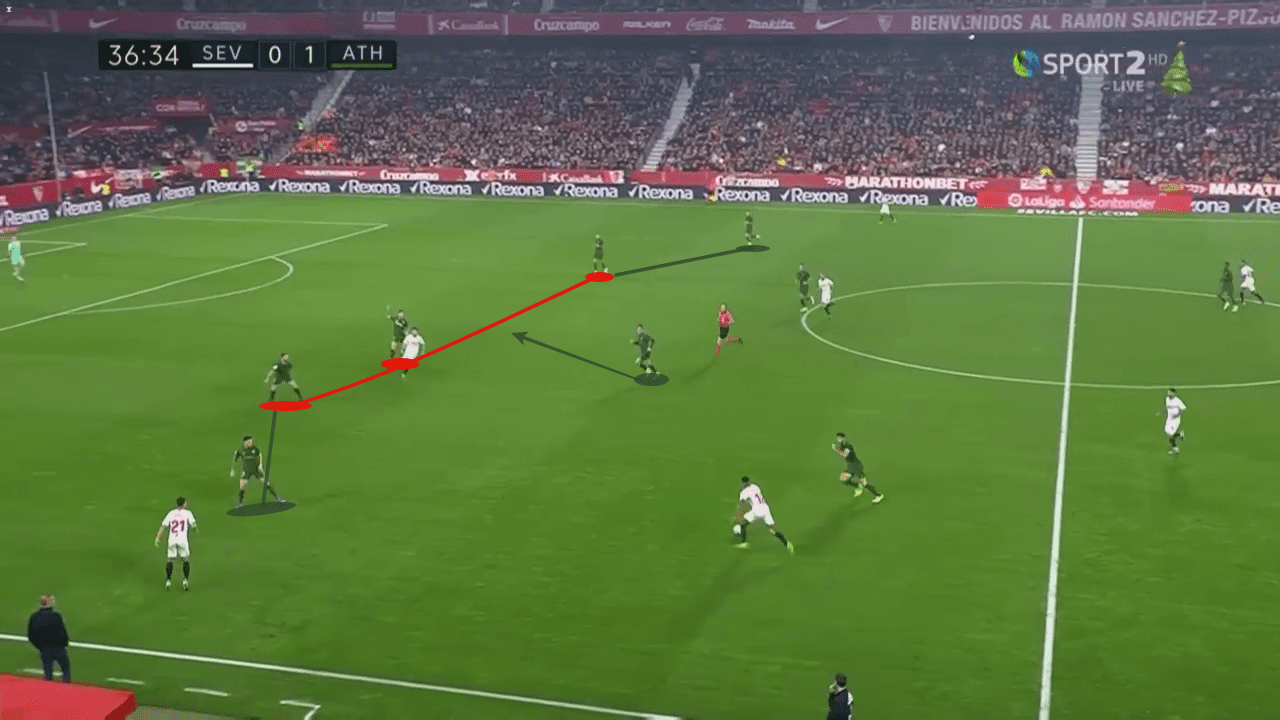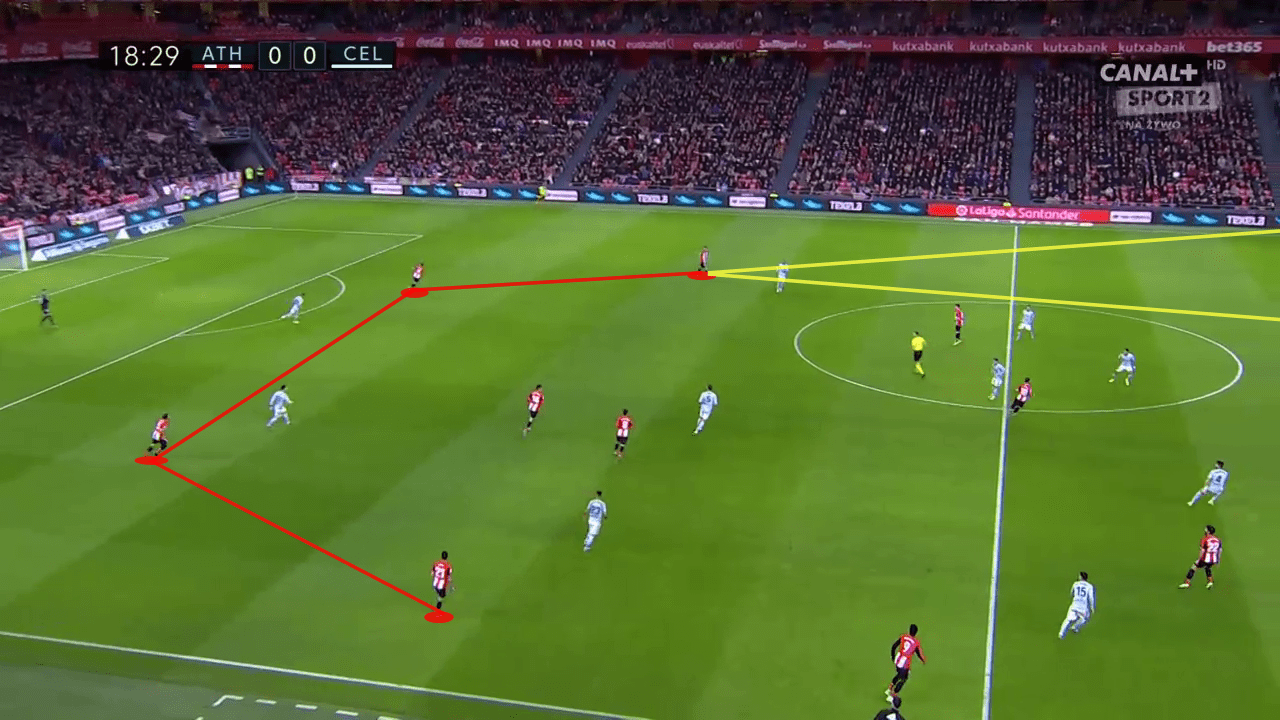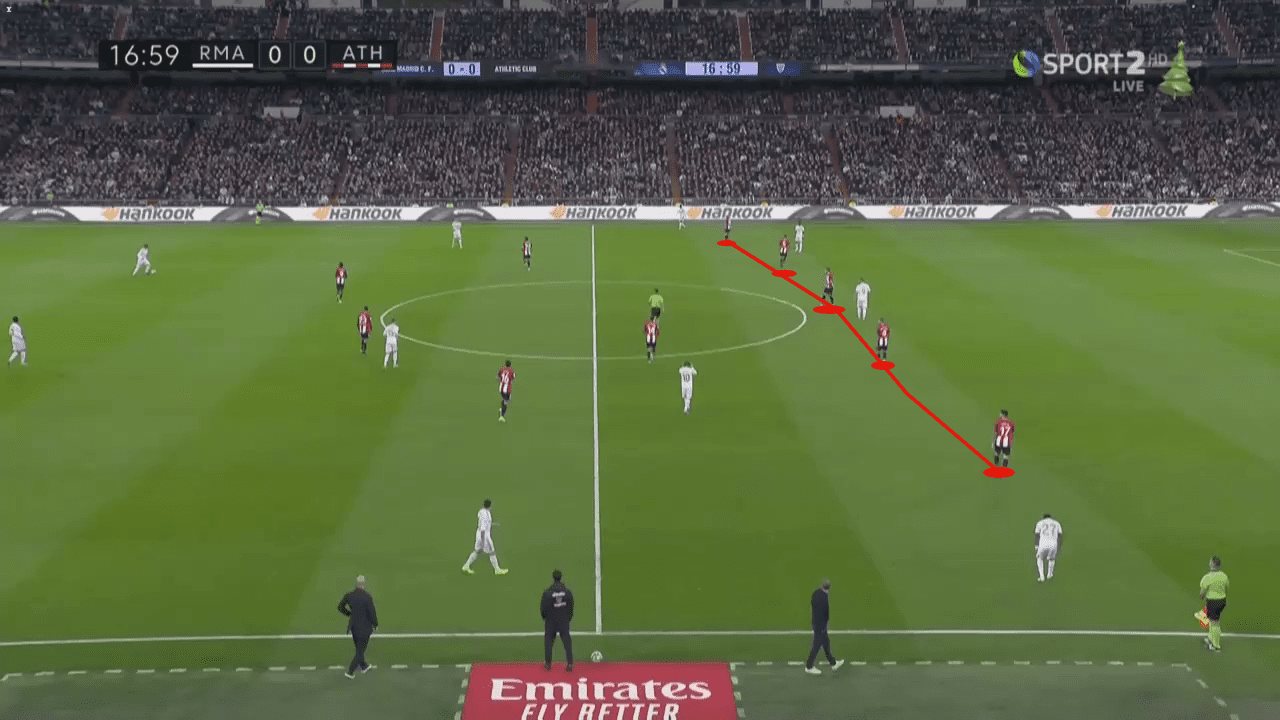Athletic Club have produced one of the most magnificent turnarounds in La Liga since the appointment of Gaizka Garitano. Their points return in the 2019 calendar year was enough to earn them a Champions League spot and they are in competition to reach that point again in the 2019/20 campaign.
Much of this has been down to the set-up used by the Basque coach, who previously led Eibar in the top flight. Particularly intriguing has been how he has altered his side defensively, looking to use three different defensive shapes across the course of the season as they have conceded just 14 goals from 20 games, with only Real Madrid having conceded fewer.
This tactical analysis will consider Garitano’s philosophy, particularly focusing the analysis upon his defensive tactics, a key element of how his team have performed so strongly in the 2019/20 season.
Three at the back
One approach which Garitano has innovated in recent months at Athletic Club has been the use of a back three. Despite making its first appearance under Garitano against Leganés in April, it has recently come back into fashion as a feasible option for the coach. Since then, it has been used against Real Betis and Sevilla and provides a system perfect for facing up against sides who use the same set-up. Presenting the coach with the chance to line-up with his star central defenders, Unai Núñez, Yeray Álvarez and Iñigo Martínez, it presents a solid option which provides both defensive stability and offensive flexibility. It is no coincidence that this set-up is the one which has produced the lowest xG against, at just 0.73 per game, compared to 0.77 per game with a back four.
In this set-up, the full-backs play a more flexible role. Ander Capa and Yuri Berchiche act almost like wing-backs, though not quite as offensive-minded as Jesús Navas and Sergio Reguilón at Sevilla, who happen to be the opponents which Garitano has used this set-up against. They are more defensive-minded, perfectly prepared to handle the threat presented by rival wing-backs, but do not necessarily form a single unit with the central defenders. They instead position themselves high up the pitch, providing an instant outlet down the flanks once possession has been turned over.

The final role is that of the holding midfielder, often Dani García. When in the defensive phase, he will often drop deep, almost becoming a fourth central defender. This is crucial as it provides the full-backs with more freedom to get forward on both flanks without concern for their defensive responsibilities. This set-up is also well suited to facing sides such as Barcelona or Real Sociedad, where playmakers like Lionel Messi or Martin Ødegaard look to occupy the space between the midfield and defence, with García providing the natural solution whilst also providing cover for the back three.
Four at the back
This approach is Garitano’s most offensive defensive system and the only most frequently used by the Athletic manager, particularly when it comes to fixtures at San Mamés. 83% of minutes played this season have been with a back four for Athletic, despite the recent changes in set-up and it also boasts the highest xG and goals scored whilst using this system, showing the importance of the extra player in the midfield and attack.
In this approach, the full-backs again play an offensive role and position themselves high up the pitch. However, in the defensive stage, they are quick to recover their positions and retain a deep, structured set-up. Typically, only one will venture forwards, with the other retaining a deeper position and sitting in to form a defensive three to provide greater protection against the counter. This will often be determined by the movement of Iñaki Williams in attack. Should he receive the ball wide, that full-back will provide an overlapping option, where should the ball not come to him, the opposite full-back will look to capitalise on the space available ahead of him to make a run from deep.

With two physically dominant options ain central defence, as is the case with all of his players, their 53.8% aerial duel success rate is the second-highest in La Liga whilst their challenge intensity is the fourth highest, showing that it is an effective approach without the requirement of more defensive figures on the field to make an impact and prevent opponents from attacking. Perhaps Garitano’s biggest challenge with this set-up is his squad management. The man to miss out has most regularly been Núñez, though he is wanted by Bayern Munich, Manchester City and other top European clubs if reports are to be believed. Maintaining him happy, without compromising the happiness and fine form of Yeray and Martínez is a challenge in itself.
Five at the back
The least frequently used set-up, but one which has been experimented with by Garitano is a rigid back five. This has only been used to date at the Estadio Santiago Bernabéu against Real Madrid. It worked highly effectively, keeping a clean sheet. It is worth noting in this consideration though, that across that 90 minutes, the side conceded 2.59 xG whilst the next highest xG conceded figure for a single match was just 1.59, against Atlético Madrid.
This approach showed no signs of the flexibility or offensive threat from the full-backs that can be seen with other systems. Instead, Yuri and Capa occupied roles as part of a solid defensive structure and rarely got forward. They were also supported by the presence of Dani García, again in the holding role, who acted as a preliminary shield and who looked to break up Real Madrid’s runners from deep like Fede Valverde and Luka Modrić.

At the heart of this tactic was the idea of denying space to Real Madrid’s front three, with a deep line preventing the pace of the Real Madrid wide men from creating space or exploiting any gaps in between the central defenders and full-backs, as they often do. By overcrowding central areas, there was little opportunity for crosses to be put into Benzema to find space, limiting Real Madrid’s preferred attacking tactic.
What will be intriguing to see is whether Garitano returns to this tactic later on this season, perhaps against the likes of Barcelona, who use a similar front three tactic which could be counteracted by the back five. At present, it seems unlikely given that Sevilla, the side most similar in style to the cross intensive Real Madrid, were up against Garitano’s 3-5-2 shape at the Estadio Ramón Sánchez Pizjúan.
Conclusion
Whereas the likes of Kuko Ziganda and Eduardo Berizzo came unstuck at San Mamés due to their stubbornness in tactics, Garitano is showing great flexibility. This adaptability according to the opposition and their approach is what has made Athletic a strong defensive side this season. With a prolific goalscorer in the side, this side would undoubtedly be competing for Champions League football. Defensively, they have kept out some of La Liga’s best attacks, using a different defensive approach for each opponent they face whilst also using their full-backs as a key part of their offensive game. These defensive foundations built by former central defender Garitano has laid the basis for a successful side.





Comments